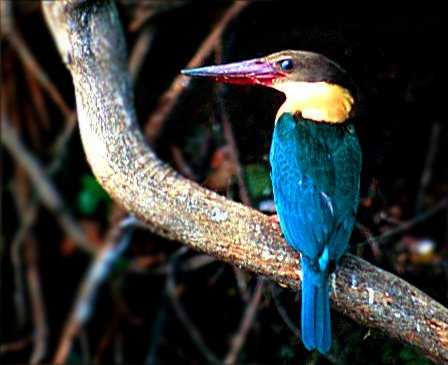|
Stork-billed Kingfisher (Pelargopsis capensis) - Wiki
| 제목: | Stork-billed Kingfisher (Pelargopsis capensis) - Wiki
| |

| 해상도: 448x365
파일크기: 35287 Bytes
등록시간: 2007:08:19 23:09:43
|
Stork-billed Kingfisher
From Wikipedia, the free encyclopedia
[Photo] Stork-billed Kingfisher from South India. Source: Photography of Kousik Nandy and Sumana Paul. Date January 2004.
The Stork-billed Kingfisher, Pelargopsis capensis (formerly Halcyon capensis), is a tree kingfisher which is widely but sparsely distributed in tropical south Asia from India and Sri Lanka to Indonesia. This kingfisher is essentially resident throughout its range.
This is a very large kingfisher, 35 cm in length. The adult has a green back, blue wings and tail, and grey head. Its underparts and neck are buff. The very large bill and legs are bright red. The flight of the Stork-billed Kingfisher is laboured and flapping, but direct.
Sexes are similar. There are 15 races, mostly differing in plumage detail, but P. c. gigantea of the Sulu Islands has a white head, neck and underparts. The call of this noisy kingfisher is a low and far reaching peer-por-por repeated every 5 seconds or so as well cackling ke-ke-ke-ke-ke-ke.
Stork-billed Kingfisher is a species of a variety of well-wooded habitats near lakes, rivers or coasts. It perches quietly whilst seeking food, and is often inconspicuous despite its size. It is territorial and will chase away eagles and other large predators. This species hunts fish, frogs, crabs, rodents and young birds.
Stork-billed Kingfisher digs its nest in a river bank, decaying tree, or a tree termite nest. A clutch of two to five round white eggs is typical.
http://en.wikipedia.org/wiki/Stork-billed_Kingfisher
| The text in this page is based on the copyrighted Wikipedia article shown in above URL. It is used under the GNU Free Documentation License. You may redistribute it, verbatim or modified, providing that you comply with the terms of the GFDL. |
|
^o^
동물그림창고 똑똑전화 누리집
^o^
|
|